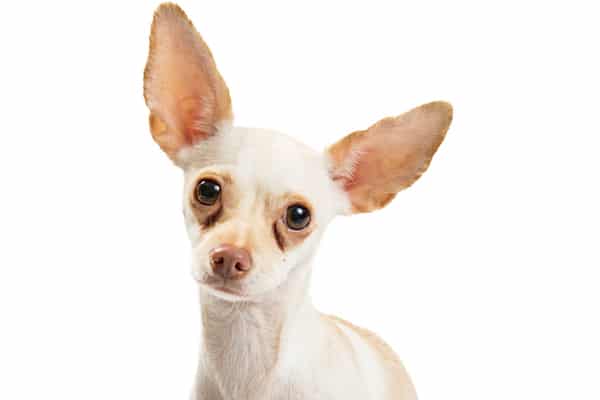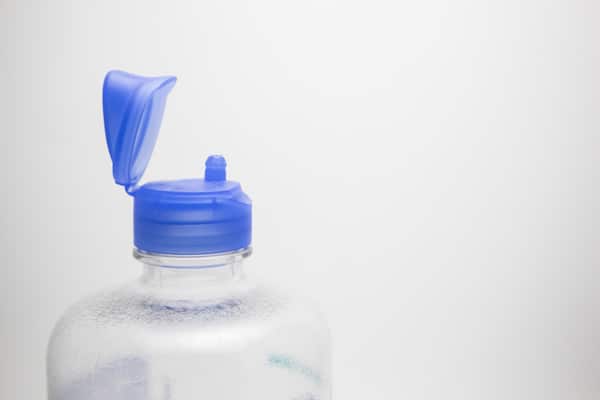For nearly 21 years, I was grateful to share life with a snowy-white Bichon ball of fluff known as Sir Lancelot of Camelot. Nope — he couldn’t joust, and he never sat at the Round Table (though he did get a “No Sir” the few times he tried begging at our rectangular dining room table). We actually called him “Sparky” for short. Both names were bestowed upon him at a rescue for abused canines; and when I looked into that brave little face, I couldn’t argue. We brought Sparky home and got him groomed so that his fur practically gleamed. All except for the dog tear stains running down his cheeks, which made it look like he was valiantly weeping over some fickle Frenchie named Guinevere.
First, what are dog tear stains?

What exactly are dog tear stains, or epiphoria? Photography by Susan Schmitz/Shutterstock.
Thanks to Sparky’s little round vanilla-white head, these chocolate-colored dog tear stains also made him look like a four-legged ice cream sundae. Realizing that there was nothing remotely noble about this, I started to do some research. What I learned is that the medical term for this issue is actually “epiphoria.” Yeah, it sounds a lot like “euphoria,” but if you’ve ever seen a dog with epiphoria or dog tear stains, you know the look resembles nothing approaching elation. “Epiphoria” actually means “watery eyes,” and in most dogs the condition creates an expression somewhere between chronically bummed out and weirdly hung over.
In certain cases, epiphoria can also be the sign of some pretty sobering health issues. Animal ophthalmologist Dr. Noelle McNabb stresses that it’s truly a symptom, rather than an outright disease. Ordinarily, dog tears help lubricate the eyes and excess fluid drains away into the lacrimal (tear) ducts on either side of the nose. Healthy ducts are shaped to drain the tears toward the back of the nose, down the throat. However, when those ducts aren’t functioning optimally, excess fluid drips down the face. This leads to dampness and tear stains.
What causes dog tear stains? And why are dog tear stains rusty-brown?
Holistic veterinarian Dr. Karen Becker explains that dog tear stains are rusty-brown because animal tears aren’t clear like human tears. They contain waste products from the breakdown of red blood cells — which means they carry naturally occurring, iron-containing molecules called porphyrins. It’s the iron that discolors those dog tears.
What’s important to note is that dog tear stains can be caused by a wide range of factors, some more serious than others. Certain dogs simply suffer from seasonal allergies. Others may have slightly misshapen or partially plugged tear ducts. Additional causes include abnormally placed eyelashes, conjunctivitis, injury, infections and even glaucoma.
So with Sparky, our first order of business was making sure these tear stains weren’t due to a pre-existing health condition. Turns out he was simply the teary type, and he teared up a LOT. This led me on a pseudo-quest for the Holy Grail of natural dog tear stain removers that may actually help alleviate this unsightly staining issue. Ultimately, my strategy boiled down to two chronological phases: prevention and cleaning.
How to prevent dog tear stains
If there’s anything I learned from the tear stains on light-colored dogs like Sparky, it’s that dog tear stains are seriously stubborn. Wiping/cleansing the area is practically futile if you’re not addressing the root cause — so focus on the following factors:
- Food: What does your pup eat daily? Forget the fancy marketing lingo on the front of the package — turn it over and look at the label. Lots of cheap carbohydrate fillers, chemical flavor additives, artificial colors, and meat by-products lead to systemic overload that can worsen dog tear stains. So first and foremost, switch your pup to a premium, balanced whole-food diet that’s rich in real meat protein. Sparky especially loved the Zignature brand, with Tiki Dog as a special-occasion treat.
- Water: Do you live in an area with hard water? Those yucky minerals leaving tea-colored rings around your drains can worsen tear stains, too. So try switching to pure filtered water. As a bonus, it also removes harmful chlorine and other toxins.
- Fluff factor: How fuzzy is your pup’s fur? Often, a gentle trim around the eye area can help remove older, darker, crustier stains. For safety’s sake, enlisting a professional pet groomer to perform this service is a smart precaution.
- pH Balance: Dr. Becker notes that slightly altering the acidity of your dog’s body chemistry can sometimes help alleviate tear staining. So try adding a teaspoon of white vinegar to a full bowl of your pup’s drinking water each day. If he rejects the taste, start with ¼ teaspoon and work up to a full teaspoon.
Dog tear stain removers

Saline solution. Photography by kpakook/Shutterstock.
Depending on the dog in question, I’ve had varying degrees of success with all of the following dog tear stain removers. If time allows, it’s best to employ all three — but at a minimum, once you’ve eliminated the surface goop, daily maintenance cleansing is a must. A quick daily face-grooming session helps minimize discoloration before it can re-accumulate.
- Natural brightening solutions: The American Kennel Club (AKC) suggests moistening a cotton gauze pad with gentle saline solution, and lightly rubbing around/underneath each eye. You can also mix one part hydrogen peroxide to four parts water. Over time, this can have a subtle brightening effect. Use a cotton swab or makeup sponge to carefully dab this diluted mixture beneath (not in) the eye area, along the sides of the nose.
- Mild cleansers: Harsh chemical additives can actually irritate the sensitive mucus membranes around the delicate eye area, intensifying the problem. So try moistening a damp washcloth with an extra-mild, non-tear baby shampoo (like Burt’s Bees Baby Bee Shampoo). Gently wipe around the face and snout area every few days.
- Barriers: I’ve had ongoing success with non-greasy, “natural barrier” products that help absorb new tears before they can saturate facial fur. These include zinc oxide ointment, and baby powder made with cornstarch (not talc). Use a tiny paint/cosmetic brush to dab a very thin layer of either beneath your dog’s eyes every day, especially near the nose. Just be careful to stay outside the lids!
Tell us: Have you ever battled stubborn dog tear stains? What dog tear stain removers do you suggest?
Thumbnail: Photography by Susan Schmitz/Shutterstock.
This post was originally published on January 3, 2017.
Read more about dog eye issues on Dogster.com:
- Dog Eye Discharge — What’s Normal and What’s Not
- Can Dogs Cry and What Exactly Is Dog Crying?
- Cherry Eye in Dogs: Tips on Prevention and Treatment
The post Dog Tear Stains — How to Make Natural Dog Tear Stain Remover (and More!) appeared first on Dogster.
No comments:
Post a Comment